Super Ideal Cut Diamonds – 4 Things You Need to Know
I recently bought this 0.62ct super ideal cut diamond ring from White Flash.
Out of the 4Cs, cut quality is undoubtedly the most important because of the impact it has on the visual appearance of the diamond. Yet, it may come as a surprise that only a small percentage of the world’s polished diamonds are cut to meet the GIA excellent or AGS ideal standards.
Out of the small percentage of excellent/ideal cut diamonds lies a subset of super ideal cut diamonds that are polished to the strictest standards and cut precision. These diamonds not only exhibit superlative brilliance and sparkle, they also display distinct hearts and arrows patterning when seen under a special viewer.
In this article, I will show you how to distinguish a super ideal cut diamond and everything you need to know before you go shopping. Let’s jump right in!
Here is a list of topics we will be covering:
- What is a Super Ideal Cut Diamond?
- #1 – Ideal Proportions for a Super Ideal Cut Diamond
- #2 – Inspect the Stone With a Hearts And Arrows Viewer
- #3 – Analyze ASET or Idealscope Data For Light Performance
- #4 – Make Sure the Diamond Has a Certificate From a Reliable Lab
- Are Super Ideal Cut Diamonds Worth It?
What is a Super Ideal Cut Diamond?
A super ideal cut diamond is usually cut to a very tight range of specifications that goes above and beyond the criteria need for an AGS ideal or GIA excellent cut grade.
Basically, the performance of a super ideal cut diamond is fine-tuned to display maximum fire, brilliance and scintillation. Using precision engineering and polishing techniques, the diamond’s contrast patterning and sparkle distribution are carefully crafted.
One of the criteria for a super ideal cut diamond is the presence of crisp hearts and arrows patterning. This kaleidoscope phenomenon can only be achieved when individual facets are precisely positioned and sized in relation to each other.
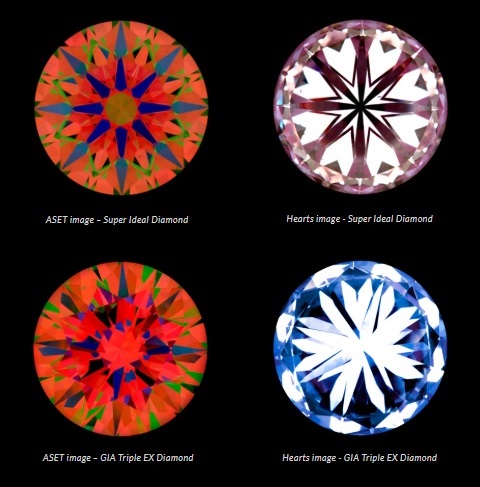
Super ideal cut vs GIA excellent cut diamond.
So, if you are in the market for a super ideal cut diamond, you need to know how to separate the wheat from the chaff. There are 4 main things you need to bear in mind when shopping for a super ideal diamond.
#1 – Ideal Proportions for a Super Ideal Cut Diamond
In order for a diamond to display maximum light return and the best sparkle possible, the facets of the diamond have to be planned and polished carefully to ideal proportions. Through scientific research and experience, I’ve compiled the following table you can use as a reference when selecting a diamond.
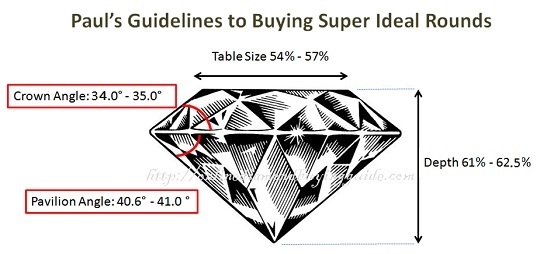
| Table % | 54.0% to 57.0% |
| Depth % | 61.0% to 62.5% |
| Crown Angle | 34.0° to 35.0° |
| Pavilion Angle | 40.6° to 41.0° |
| Lower Girdles | 75% to 80% |
| Star Facets | 50% to 55% |
| Girdle Thickness | T – M – ST |
Table of super ideal cut diamond proportions.
Diamonds that fall outside of these proportions would usually result in a diamond with mediocre light return. This is due to the physics of light and how light is refracted/reflected when traversing the diamond.
Now, I want to point out that just because a diamond possesses ideal proportions, it doesn’t automatically qualify the diamond as a super ideal cut. You will need to rely on more tangible data for confirmation (continue reading for details).
Think of it this way – bad proportions will almost always guarantee a poor light performance, but good proportions are only a prerequisite and don’t guarantee ideal light performance.
#2 – Inspect the Stone With a Hearts And Arrows Viewer
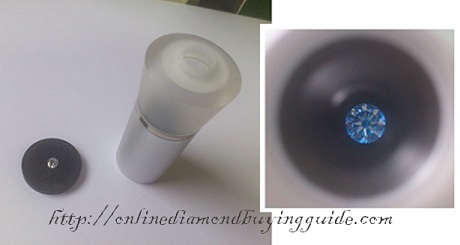
Viewing the hearts and arrows patterning using a special viewer.
Regardless of what the jeweler may claim or say about the diamonds they are selling, you always want to verify details yourself.
A super ideal cut diamond will display pristine hearts and arrows patterning which is extremely difficult to achieve. I’ve written a comprehensive article about the technical guidelines for analyzing a diamond’s optical symmetry. If you are unsure, you can refer to the link and use it as a reference for making comparisons.
Tip: Always pay more attention to the hearts patterning. Properly formed hearts require super precise facet placements and proportioning. Any slight deviations in facet alignments will show up in the pavilion view instead of the table (arrows) view.
As an example, the image below might be passed off as a “great” diamond to the untrained eyes. However, what it really shows is a poor patterning with malformed hearts and inconsistent spacings.
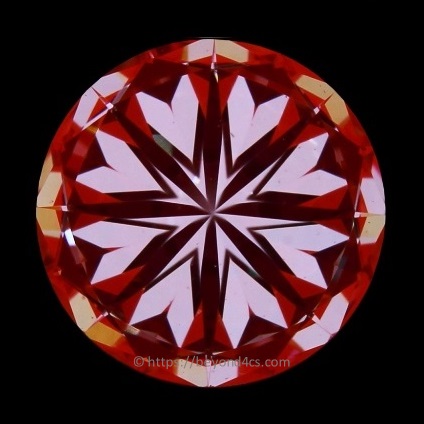
This type of hearts patterning is indicative of lousy cut precision and craftsmanship. And to state the obvious, this stone would not pass my standards for a “true” hearts and arrows diamond.
In fact, I won’t even bother wasting time on a mediocre stone like this. If a jeweler is trying to pass a similar diamond off as a “super ideal cut”, you better run for the doors.
#3 – Analyze ASET or Idealscope Data For Light Performance
A super ideal cut diamond needs to fulfill many strict technical criteria before it can be rightly labeled as such. However, at the end of the day, the tangible output that matters to most consumers is the sparkle and brilliance the diamond displays.
Without light performance, any optical symmetry that the stone possesses is naught. What’s the point of having a diamond that displays nice patternings under an H&A viewer if it appears dull and lifeless when worn?
To make an objective analysis of light performance, there are 2 tools you can use: the Idealscope and ASET. Both of these tools offer an easy analysis of how light would interact with the diamond.
Here’s what you should expect to see in a super ideal cut diamond:
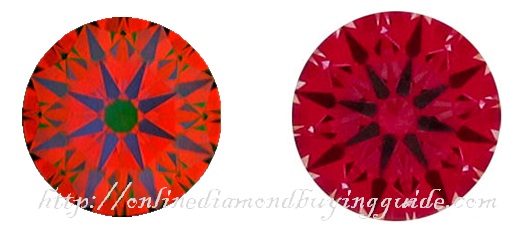
ASET (left) and Idealscope (right) image of a super ideal cut diamond.
I know I’m starting to sound like a broken record with the constant harping on the need for tangible data. But it’s really important because the ASET and Idealscope provide objective data you can use to assess a diamond’s performance easily.
All you need to do is to perform comparisons of the scope images against the reference charts I have listed here for ASET and Idealscope and you will immediately know the level of light performance the diamond has.
Remember, no 2 diamonds are exactly the same. If you had read my review of Hearts On Fire, you would have known that optical symmetry doesn’t necessarily translate into better light performance.
#4 – Make Sure the Diamond Has a Certificate From a Reliable Lab
While this may sound like common sense, there are many consumers who fall prey to deceptive marketing tactics and end up overpaying for their purchase. Bear this in mind: lab reports are not made equal.
Grade bumping is a common issue where a low-quality diamond (usually with dubious certification) is marketed to be the equivalent of a similarly graded GIA diamond.
For example, an EGL diamond graded with E Color SI1 is not the same as a GIA stone with a grade of E Color SI1. An EGL diamond is going to be multiple color/clarity grades lower than what is stated in the grading report.
As a result of misrepresentation and inaccurate grading, uneducated consumers often get ripped off by overpaying for inferior-quality diamonds. The bottomline here is, I only recommend buying diamonds graded by GIA or AGS as they are highly reliable and have strict, consistent grading standards.
Lastly, Are Super Ideal Cut Diamonds Worth It?
Real life appearances of different shapes of super ideal cut diamonds.
The importance of buying a hearts and arrows diamond (super ideal cut) is often a topic of debate by industry professionals. While it’s undeniable that a true hearts and arrows cut diamond has ideal light return and optical symmetry, this comes at a cost.
Super ideal cut diamonds have to be polished to a very tight set of proportions and extreme precision. This is painstakingly done by a skilled craftsman who puts in more time on the polishing and requires more weight to be removed from the rough diamond.
As a result, the super ideal cut diamond can be 10-15% more expensive compared to an above-average GIA 3Ex or AGS 000 ‘near hearts and arrows’ diamond.
Now, I know some people would argue that there are diminishing returns in brilliance and sparkle since it is hard for a layman to differentiate between a super ideal or a GIA 3Ex diamond. Some may even argue that the H&A pattern can only be seen with a special viewer and wouldn’t make any differences to a casual viewer.
These are all valid points but I personally think it is worth it to buy a super ideal cut diamond. There is a visual improvement in appearance because of the symmetrical contrast patterning displayed by H&A diamonds. Also, knowing that a diamond has the best of the best cut quality in the world adds to the enjoyment of wearing and owning the diamond ring.
Related Articles
Leave A Comment

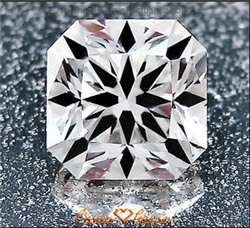
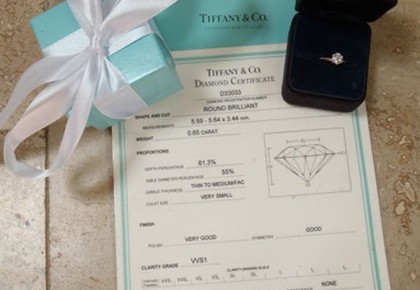

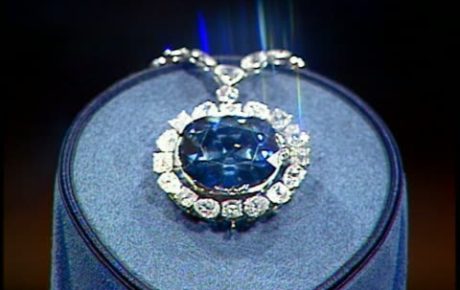









28 Comments
hi i have a question,i have a diamant ring from GIA with laser inscription,0,47 carat,3 x excellent cut ,and vvs2 g colour,fluences none,but what is the difference between a diamond and the hearts and arrows stone is the stone that i have not even good enough as a hearts and arrows,and what is the difference between vvs1 and 2, and what is the difference between super ideal cut vs excellent cut. greetings chantal baas from the netherlands
The differences between VVS1 and VVS2 are largely technical. VVS1 diamonds will only have inclusions found on the pavilion side whereas VVS2 allows for inclusions found on the crown and pavilion side. Both grades will definitely be eyeclean so that’s something you don’t have to worry about.
You may want to read this article as well: https://beyond4cs.com/hearts-and-arrows/
The differences between a super ideal cut vs excellent cut would depend on a case by case basis. In most instances, the excellent cut diamond will not have a symmetrical contrast patterning nor light return level on par with the super ideal.
Hi Paul, what does it means if the inner middle circe of the diamond seen under ASET is not entirely green (about 1/4 of it is red)? May that be a problem? Also, I noticed that some of the AGS reports contain a rainbow colored scan of the hearts and arrows patterning. Can you offer some insights into their usefulness? Thanks
It’s a reflection of the table facet within the diamond and isn’t something I would be concerned with.
https://beyond4cs.com/2012/11/green-or-red-in-middle-of-aset/
Interestingly, many lesser-known labs do provide information about the diamond’s optical symmetry in their grading report. Most of the time, this is just a weak attempt to stand out from the competition by offering “additional services”.
I want to call out a lab called EGL that uses something called the Hearts & Arrows Diamond Report. This scummy lab has questionable grading standards and giving you some “extra” details doesn’t change the fact that these labs apply soft grading standards during their examination.
Remember, the purpose of a reliable certificate is to help consumers verify the diamond’s authenticity and to provide an accurate description of the qualities it possesses.
Now, there is one exception and that is the computer scans offered by AGS laboratory. As an example, this is what the H&A computer generated patterning looks like. I would still require an examination of the diamond’s hearts patterning via photography to be certain of its cut precision as these scans aren’t 100% accurate.
HI Paul,
I have been following your diamond selection guide write up and gained the basic knowledge of viewing those diamonds. I have screened the following two diamonds and would like to have your advise on which one is the better buy in terms of their quality?
What’s wrong with just buying a GIA excellent cut grade or AGS 0 cut grade diamond? Hearts and arrows diamonds look like a hype to me abut I don’t profess to understand all the intricacies involved between the different cutting styles.
Thanks!
https://www.jamesallen.com/loose-diamonds/round-cut/0.46-carat-d-color-vs1-clarity-excellent-cut-sku-2210757
https://www.jamesallen.com/loose-diamonds/round-cut/0.45-carat-d-color-vvs2-clarity-excellent-cut-sku-2289861
Both are on par. You did well. I think this diamond would be a better buy:
https://www.jamesallen.com/loose-diamonds/round-cut/0.91-carat-g-color-vs2-clarity-excellent-cut-sku-2376023
It depends on what you are looking for. The GIA excellent cut grade is very broad and there’s a range of mediocre and well cut diamonds all thrown in the mix. With a GIA excellent grade, you can be assured that the diamond has adequate brilliance but it isn’t enough for everyone. For someone like myself, I want the best sparkle in a diamond that will capture someone’s attention across the room when I wear the diamond ring. There are visual differences in sparkle and patterning between a super ideal vs a typical excellent cut diamond. The engineering and skills needed to create a super ideal diamond is something that I admire and respect as I come from an engineering background.
Since we are dealing with premium cuts and super ideal diamonds, there is a significant price jump involved. For a $100,000 diamond, that can mean a difference of tens of thousands of dollars. That’s why it makes sense for you to know exactly what you are buying and I hope the knowledge empowers you to make better decisions without relying on the words of a jeweler who has vested interest in making you buy the diamond.
Hi Paul, thank you for all of the information. I have narrowed down to these 2 diamonds, can you please let me know your thoughts and which is best? Thank you!
https://www.jamesallen.com/loose-diamonds/round-cut/1.66-carat-g-color-vs2-clarity-ideal-cut-sku-1907535
https://www.jamesallen.com/loose-diamonds/round-cut/1.61-carat-g-color-vs2-clarity-ideal-cut-sku-1783916
A third more expensive option also made my cut, not sure if worth the extra money:
https://www.jamesallen.com/loose-diamonds/round-cut/1.65-carat-e-color-vs2-clarity-ideal-cut-sku-631114
hello- I’m a jewelry appraiser and I’m getting mixed answers to my question, what is the percentage or premium for HAA over a regular ideal cut diamond?
It depends on how precise the cut quality of H&A is. Different jewelers have different standards and that’s the part that screw people over. For a top notch H&A diamond compared to a bottom of the barrel ideal cut diamond, the price differences can be up to 20%.
The 3rd diamond would be the best option in terms of overall cut quality. That’s the stone I would personally buy.
Hi Paul, thanks for the great website and detailed information. I’m looking at the diamond below which is listed as a True Hearts. Would like your thoughts if it meets your criteria?
https://www.jamesallen.com/loose-diamonds/round-cut/1.70-carat-g-color-vs1-clarity-excellent-cut-sku-2634010
No it doesn’t. The table size is too large. If you are interested in getting a top notch hearts and arrows diamond, go to White Flash or Brian Gavin.
https://beyond4cs.com/go/wf/
https://beyond4cs.com/go/briangavin/
HI Paul, I really appreciate your website! I have a question about diamond table measurements. What do you consider too large of a table measurement? I was under the impression that because a large table could make the diamond look bigger it was always better to have a diamond with a large table, but when does it interfere with the brilliance of the diamond? Is it in direct correlation with the diamond depth and if so, can you use the depth to know if the table is too big? I’m confused. Thanks for your help!
Well, you are definitely under the wrong impression. For a round diamond, anything above 58% is excessive. Larger tables mean crown facets get smaller and this affects the balance of fire and brightness.
Hi Paul!
First of all, thank you so much for this site. I almost made a giant mistake of overpaying for a terrible diamond in a local store. Because of you, I found Brian Gavin online.
Can you show me examples of GIA super ideal cut diamonds? The ones that are frequently seen at White Flash and Brian Gavin are all AGS certified. Are there any differences between GIA super ideals and AGS super ideals?
I have narrowed down my choices to three diamonds and I was wondering if you can help me select the best one for the price. The most important thing to me are sparkle and eye clean-ness. Also, I’d prefer to not have a noticeable tinge. Thank you!
http://www.briangavindiamonds.com/diamonds/diamond-details/1.505-g-vs2-round-diamond-ags-104090535096
http://www.briangavindiamonds.com/diamonds/diamond-details/1.528-f-si1-round-diamond-ags-104095011008
http://www.briangavindiamonds.com/diamonds/diamond-details/1.514-g-si1-round-diamond-ags-104095011009
With a F or G color, I can assure you that you will not see any body color in the diamonds. They will face up icy white.
These 2 diamonds will be my top picks:
http://www.briangavindiamonds.com/diamonds/diamond-details/1.528-f-si1-round-diamond-ags-104095011008 best overall value for money.
http://www.briangavindiamonds.com/diamonds/diamond-details/1.514-g-si1-round-diamond-ags-104095011009 would be my 2nd choice if you have budget constraints.
Either way, both stones are fantastic and top notch.
Both GIA and AGS are reliable labs. It’s just that the better cut diamonds tend to get sent to AGS and that’s why most of the super ideal diamonds have an AGS certification. For GIA, you need to do some digging and really understand what you are doing to find the truly well cut stones.
Here are 2 such examples:
https://www.jamesallen.com/loose-diamonds/round-cut/1.03-carat-f-color-si1-clarity-true-hearts-cut-sku-7485319
https://www.jamesallen.com/loose-diamonds/round-cut/0.50-carat-g-color-vs1-clarity-true-hearts-cut-sku-6581196
Hi Paul,
I’ve looked again at the F diamond you recommended. I’m a bit concerned about the inclusion plot. All the inclusions are bunched together under the table. Is that going to be a problem? I thought one is supposed to avoid inclusions under the table?
The stone is eyeclean and that’s all that matters if you are a practical buyer. You will NOT see inclusions with the naked eye. If you were to blindly follow advice that one should avoid all inclusions under the table, are you going to avoid a VVS2 diamond with a small pinpoint as well? If that bothers you (which is ridiculous), then pay the premium for an IF diamond.
I will restate: the diamond is eyeclean. If it wasn’t, I won’t have recommended it.
https://beyond4cs.com/clarity/resize-technique/
Hi Paul, First of all thank you for your great website. It has made my search a lot more manageable after understanding the differences between ideal vs super ideal cut.
With my interpretation of all your information I’ve been able to narrow my options to the following two, I’d greatly appreciate your input:
https://www.whiteflash.com/loose-diamonds/round-cut-loose-diamond-3836182.htm
https://www.whiteflash.com/loose-diamonds/round-cut-loose-diamond-3885288.htm
If you have any additional options that I should consider those are welcome too! I note that the options I shortlisted above are all AGS certified. Would there be any differences between AGS and GIA super ideal cut diamonds if they exist?
Thank you again for this amazing website!
There are very limited GIA super ideal cut diamonds in the market because the cutters will send these stones to AGS for a certification. The reason they do this is that AGS is stricter in cut quality and more recognized than GIA when super ideal cuts are involved.
I looked at both stones below and think you did well to pick these out. Personally, I would try to stay with a G or better color if budget allows.
Cutwise, both diamonds are spectacular and top notch in terms of performance.
I have preference for the G diamond above and that’s the stone I would buy. Either way, both stones are stunners and you can’t go wrong with either one.
Paul
Paul,
First off, thanks so much for this phenomenal web resource you put together. I was extremely wary about trying to navigate the diamond market before I came across your site. No, after spending much of the last week devouring all of the learning you’ve shared with us here, I feel much more confident about things. I have to admit, I even find the diamond industry a bit fascinating now, which is something I never thought I’d say. I’ll definitely be making sure that I follow one of your affiliate links when I make the purchase; you’ve more than earned whatever referral fee they pay you!
The reason for my question: I’m buying an engagement ring, and before I pulled the trigger, was hoping I could get a second opinion from you.
My goal is to find something slightly under 2 carats, round cut, with the optimal sparkle, so I’ve tried to prioritize cut-cut-cut here. Here are the three leading contenders:
https://www.whiteflash.com/loose-diamonds/round-cut-loose-diamond-4123888.htm
https://www.whiteflash.com/loose-diamonds/round-cut-loose-diamond-4049800.htm
https://www.whiteflash.com/loose-diamonds/round-cut-loose-diamond-4015037.htm
I’m really having a hard time identifying much difference between these on the ASET and Ideal-Scope images. But I think my preference among these is for the 1st one, mostly because the inclusions near the center on the 2nd and 3rd ones seem more visible in the magnified face-up images. All three list as eye-clean, though, so will those even really make a difference? The HCA analysis for the 3rd one comes in a little lower (0.9) than it does for the other two (1.1), so that was another factor that I wasn’t really sure how much weight to assign.
I was also considering this stone from the Black collection at Brian Gavin, which also rated at 0.9 on the HCA analysis:
https://www.briangavindiamonds.com/diamonds/diamond-details/1.860-g-vs2-round-diamond-bkags-104106420027
Any thoughts between these would be much appreciated. Thanks again for the brilliant website!
I actually pay no heed to the HCA tool given how these vendors provide tangible data to assess cut quality. It’s an outdated tool that serves to confuse more than it helps when making a selection. Now, I reviewed all 4 diamonds you shortlisted and all of them are exceptionally well cut. You have a first world problem because all these diamonds are consistently well cut and there are virtually no differences in light performance. That also points to the high standards that both White Flash and Brian Gavin has.
Now, out of these 4 diamonds, I do have the strongest preference for this diamond to get the best value for money. The other 2 WF diamonds have inclusions I am not comfortable with.
https://www.whiteflash.com/loose-diamonds/round-cut-loose-diamond-4123888.htm
The next diamond I would consider this diamond: https://www.briangavindiamonds.com/diamonds/diamond-details/1.860-g-vs2-round-diamond-bkags-104106420027
Both are fantastic options and I would let the choice of setting decide on whom to work with. Good job in picking out these options.
Hi Paul, as someone new to searching for diamonds and rings, I can’t thank you enough for creating your site, compiling your wealth of knowledge, and actively reading and responding to readers’ comments and questions.
I’ve combined info from this article with your wonderful write-up of “the ultimate guide for round-cut diamonds” to practice and narrow down my search for an engagement ring diamond.
I found this diamond (I’ll call it number 1: https://www.briangavindiamonds.com/diamonds/diamond-details/0.506-g-vvs2-round-diamond-ags-c-104107046008, which doesn’t have an arrows image on Brian Gavin’s site, but does have a light performance map as part of the lab report. Does this diamond make the cut (pun intended), and is it something you’d consider top notch?
I’m looking at several alternatives that are within my budget, and they all seem like good deals — are there any obvious flaws that I might not be aware of?
2) 0.545 G SI1 (this one seems like a really good deal): https://www.briangavindiamonds.com/diamonds/diamond-details/0.545-g-si1-round-diamond-ags-c-104104773099
3) 0.562 ct G SI1 (this one seems like a really good deal as well): https://www.whiteflash.com/loose-diamonds/round-cut-loose-diamond-4153197.htm
4) 0.507 G SI1 (this seems like a big price dip compared to #1 with the main difference being the clarity rating): https://www.briangavindiamonds.com/diamonds/diamond-details/0.507-g-si1-round-diamond-ags-c-104104763068
5) 0.554 ct G VS1 (also seems like a good deal around the same price point as #1): https://www.whiteflash.com/loose-diamonds/round-cut-loose-diamond-3968187.htm
If you don’t have time to check all of these, no worries – I completely understand. Appreciate any help and advice, and thanks for your time!
I reviewed all 5 diamonds and they are all top-notch in light return and cut precision. That’s how good WF and BGD are in their consistency and quality. Out of these 5, these are the 2 that I would personally buy and recommend:
https://www.briangavindiamonds.com/diamonds/diamond-details/0.545-g-si1-round-diamond-ags-c-104104773099
https://www.whiteflash.com/loose-diamonds/round-cut-loose-diamond-4153197.htm
Both of these SI1 diamonds are eyeclean and the inclusions are very minute. There’s no need to pay a premium for higher clarity grades. In real life, they will look identical to the other 3 diamonds with the exception of being bigger.
Read: https://beyond4cs.com/clarity/resize-technique/ and then click the links above to do the test on each of the diamonds for yourself. I don’t think you would ever see any inclusions with the naked eyes in real life.
Given that both are similarly priced and have superb light return, I would let the choice of setting decide on which vendor to work with. Either way, both are winners!
https://www.whiteflash.com/loose-diamonds/compare/?idnos=4222760,4457052,4445446
If you are able to pull this site up would you please comment on my recent purchase from Whiteflash. I have a 30 day return window and would like to be sure I’m getting a good pair. (The 2 that say sold on the left).
Thanks, really appreciate all the knowledge I acquire by following your articles. Without this I would have been buying blindly and probably would only end up with a good pair of diamonds by sheer luck.
I can confirm that these 2 diamonds that are picked by you are superbly cut and are eyeclean. You clearly know what you are doing. Good job in picking them out.
That is correct. A diamond doesn’t necessarily need crisp hearts and arrows patterning in order for it to display good light return. Optical symmetry (H&A) affects contrast patterning but may not directly affect light return. These are 2 separate things. But I will say that well cut stones normally display BOTH great light return and precise contrast patterning.
Hi Paul.
I have a question.
In the first picture where you compare the aset images of a super ideal stone and a regular Gia 3ex stone,
the Gia 3ex stone may not have crisp hearts and arrows patterning
But if its aset image has so much red as in the first picture,
Doesn’t that mean that its light performance is somehow still very great?
Thank you Paul in advance.